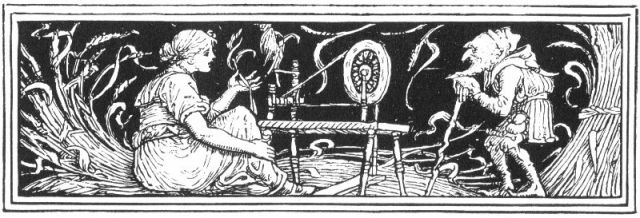by Jerry Cayford
 “This is the story of a man. Not rich and powerful, not a big man like your father, Sweetheart. Just a funny little man. I didn’t know him long, only three nights. But there was something about him, something magical.” If “Rumpelstiltskin” started with this framing, we would have a different picture of the story’s meaning, a truer picture, for this framing suggests what is hidden below the surface.
“This is the story of a man. Not rich and powerful, not a big man like your father, Sweetheart. Just a funny little man. I didn’t know him long, only three nights. But there was something about him, something magical.” If “Rumpelstiltskin” started with this framing, we would have a different picture of the story’s meaning, a truer picture, for this framing suggests what is hidden below the surface.
The miller’s daughter is our “shadow” narrator. No one else witnesses the central events of the story, except Rumpelstiltskin, and he’s dead. We get suspicious that the story she’s telling makes her look too good: the beautiful victim, abused by everyone, who somehow ends up with the king, the gold, the servants, and the child, and never has to pay her debts. Clues pile up, starting from Rumpelstiltskin’s death. He “ripped himself up the middle in two” and sank into the earth. The poor sap killed himself. Why? We follow the trail of breadcrumbs. Why would the guy want the daughter’s firstborn? Sounds like a euphemism… That’s it! The bargain wasn’t for the child but for the woman! It’s the oldest bargain in the world. But if that was the deal… paydirt: Rumpelstiltskin is the child’s father!
There is plenty to uncover in this fairy-tale-noir story of illicit sex, betrayal, obsession, and suicide, but you have to believe it is worth digging. Perhaps if I tell you the story is older than the bible: “Rumpelstiltskin, in summary, is one of the earliest known narratives in Western literature” (Oliver Tearle). Scholars have traced the story back to languages long vanished. As Tearle puts it, “The story obviously has its roots deep in the most primal and basic drives and emotions which are commonly shared throughout humanity.” Read more »
